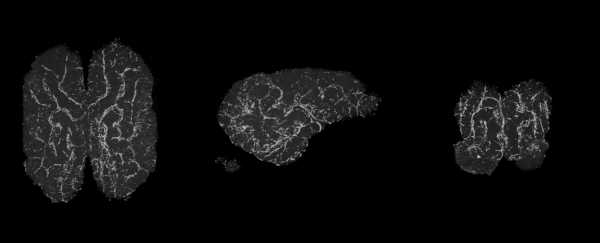For the first time, scientists have managed to bring a flutter of life back into dead brains. With a new system, neuroscientists have restored some cellular and molecular function to the brains of pigs that had been dead for four hours.
It's a tremendous achievement, and one that heralds a new way of studying the postmortem brain. It could even lead to new treatments for cell death caused by brain damage and disease.
Since Mary Shelley's science fiction novel Frankenstein first entered the world in 1818, humans have been dreaming of restoring life to the brain. That, to be utterly crystal clear, is not what we're looking at here.
Rather, the Modern Pigmetheus was an attempt to discover what happens in the brain after blood flow stops, and whether cell death is as inevitable as it seemed.
"The brain is highly sensitive to changes in oxygen level and interruptions in blood flow," explained neuroscientist Nenad Sestan of Yale University in a press briefing.
"However, multiple observations from our lab and others have questioned the notion that widespread cell death is unavoidable minutes or even hours after blood flow stops. For example, live cells can be harvested from postmortem brains and cultured in a dish. This indicates itself that the postmortem brain may have the capacity to be revived."
He and his team developed a system called BrainEx - meaning brain ex vivo - consisting of three parts.
The first part is a synthetic solution designed to be pumped through the brain in a manner similar to the heart - perfusion - at body temperatures around 37 degrees Celsius.
The second part is the perfusion device itself, which pumps the solution and mimics the supporting organs. The final part is the surgical technique that allows the brain to be isolated.
 Simplified schematic of BrainEx. (Vrselja et al., Nature, 2019)
Simplified schematic of BrainEx. (Vrselja et al., Nature, 2019)
The team then obtained 32 pig brains from a food processing facility, meaning no animals had to be killed for the research, and applied the BrainEx technology four hours after death, to model the effects of prolonged brain injury.
The brains were perfused for six hours. At this point, the team was able to observe a clear difference between the BrainEx brains and the control brains, which either weren't treated, or were perfused with a control solution.
"We found that tissue and cellular structure is preserved, and that cell death is reduced," Sestan said.
"In addition, some molecular and cellular functions were restored, including glial and vascular response to stimuli, as well as spontaneous synaptic activity along with active global metabolism."
 (Stefano G. Daniele & Zvonimir Vrselja; Sestan Laboratory; Yale School of Medicine)
(Stefano G. Daniele & Zvonimir Vrselja; Sestan Laboratory; Yale School of Medicine)
Above: At 10 hours, an untreated brain on the left, BrainEx on the right. Green is neurons, red is astrocytes, blue is cell nuclei.
However, there was absolutely no sign of the organised global activity necessary for normal brain function or consciousness. The team heavily stressed that, not only was that not the goal of the research, but had they any hint of organised global activity, they would have had to terminate the research.
In fact, they had anaesthetic and termination protocols ready just in case consciousness was detected, and the BrainEx perfusate solution included a neuronal activity blocker.
"This is brand new, and there's no kind of institutional oversight," said bioethicist Stephen Latham of Yale University.
"This is not animal research, because the brain comes to the researchers from an already dead animal. But if consciousness were somehow induced in the brain, we don't have ethics committees … that are constituted to even think about how to do the kinds of trade-offs you do when you do research on human subjects or on animals."
What the findings do tell us is that the brain has a much greater capacity for the restoration of cellular function than we knew. And it could lead to, for example, an improved set of tools for treating stroke, trauma or prolonged lack of oxygen.
And it provides a new way to study the postmortem brain. Researchers could use BrainEx to study the effects of injury on the dynamics of the brain, or the effects of certain drugs. Or even just the dynamics of the large mammalian brain itself, which is pretty difficult to do in living organisms.
"Our technology requires further development, optimisation, and implementation, including studies with longer perfusion times. This experimental approach may have broader applications than those described herein, and could potentially help to bridge the gap between basic neuroscience and clinical research, especially as it pertains to the human brain," the researchers wrote in their paper.
"Future studies and considerations will spur further development and implementation of this technology to study broad scientific questions in the large, mammalian brain."
The research has been published in Nature.
